IBUS 1000 Sem 1: Crisis Management Frameworks and Case Study Report
VerifiedAdded on 2022/11/26
|14
|4144
|395
Report
AI Summary
This report undertakes an analysis of crisis management within the context of international business, focusing on risk assessment, mitigation, and response strategies. It begins by defining crisis and crisis management, emphasizing their importance in the modern business environment, and identifies various types of crises. The report then compares two key crisis management frameworks: the three-stage framework (pre-crisis, crisis, post-crisis) and the five-stage framework (signal detection, planning, crisis management, recovery, and learning). The core of the report applies the five-stage framework to the 'strawberry needle crisis' that affected the Australian retail sector, specifically examining its impact on Woolworths. The analysis considers the crisis's origins, the framework's implementation, and the strategies Woolworths could have employed for effective crisis management, including signal detection and recovery processes. The report concludes by highlighting the importance of proactive crisis planning and response in safeguarding organizational stability and reputation in the face of unexpected events.
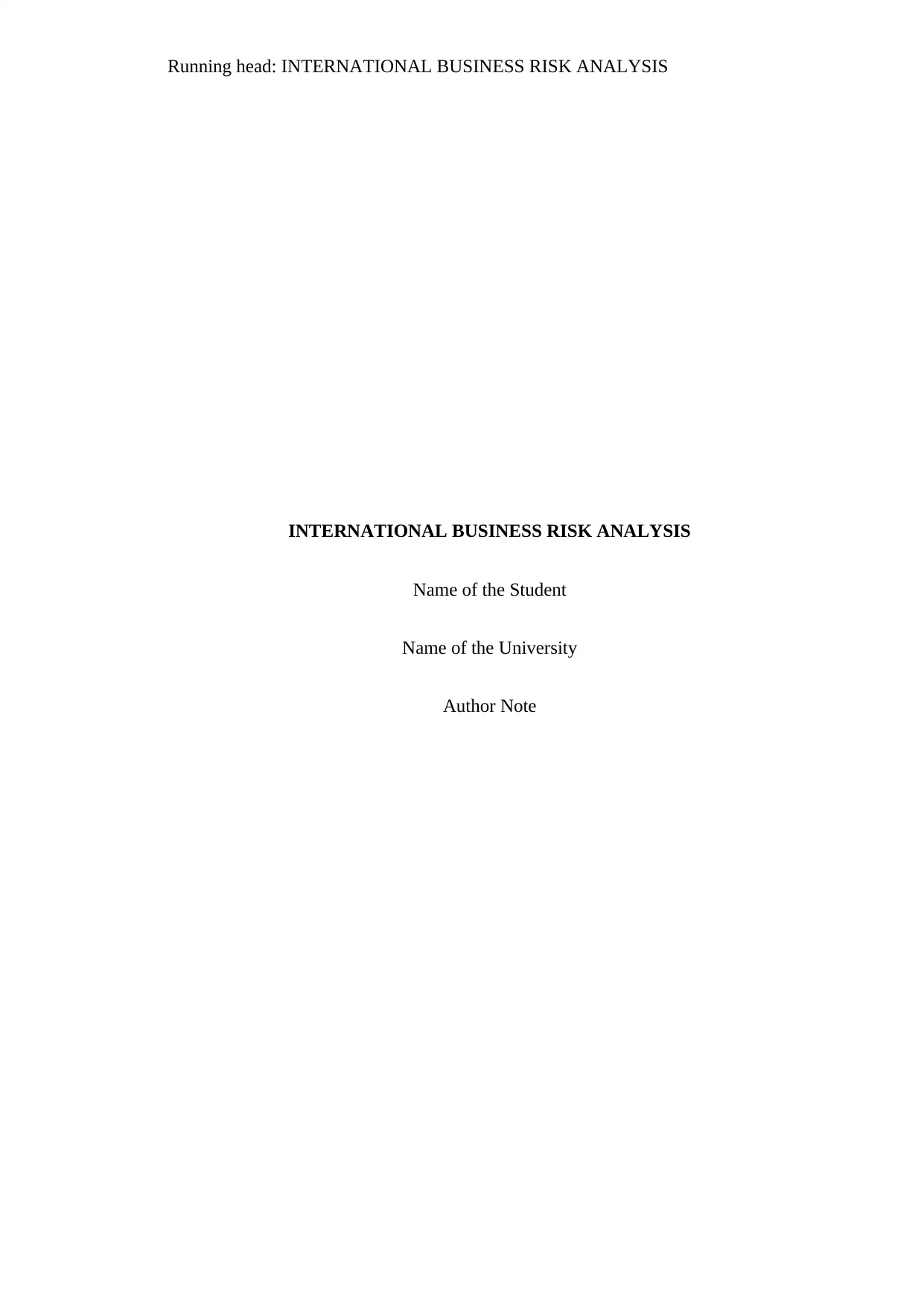
Running head: INTERNATIONAL BUSINESS RISK ANALYSIS
INTERNATIONAL BUSINESS RISK ANALYSIS
Name of the Student
Name of the University
Author Note
INTERNATIONAL BUSINESS RISK ANALYSIS
Name of the Student
Name of the University
Author Note
Paraphrase This Document
Need a fresh take? Get an instant paraphrase of this document with our AI Paraphraser
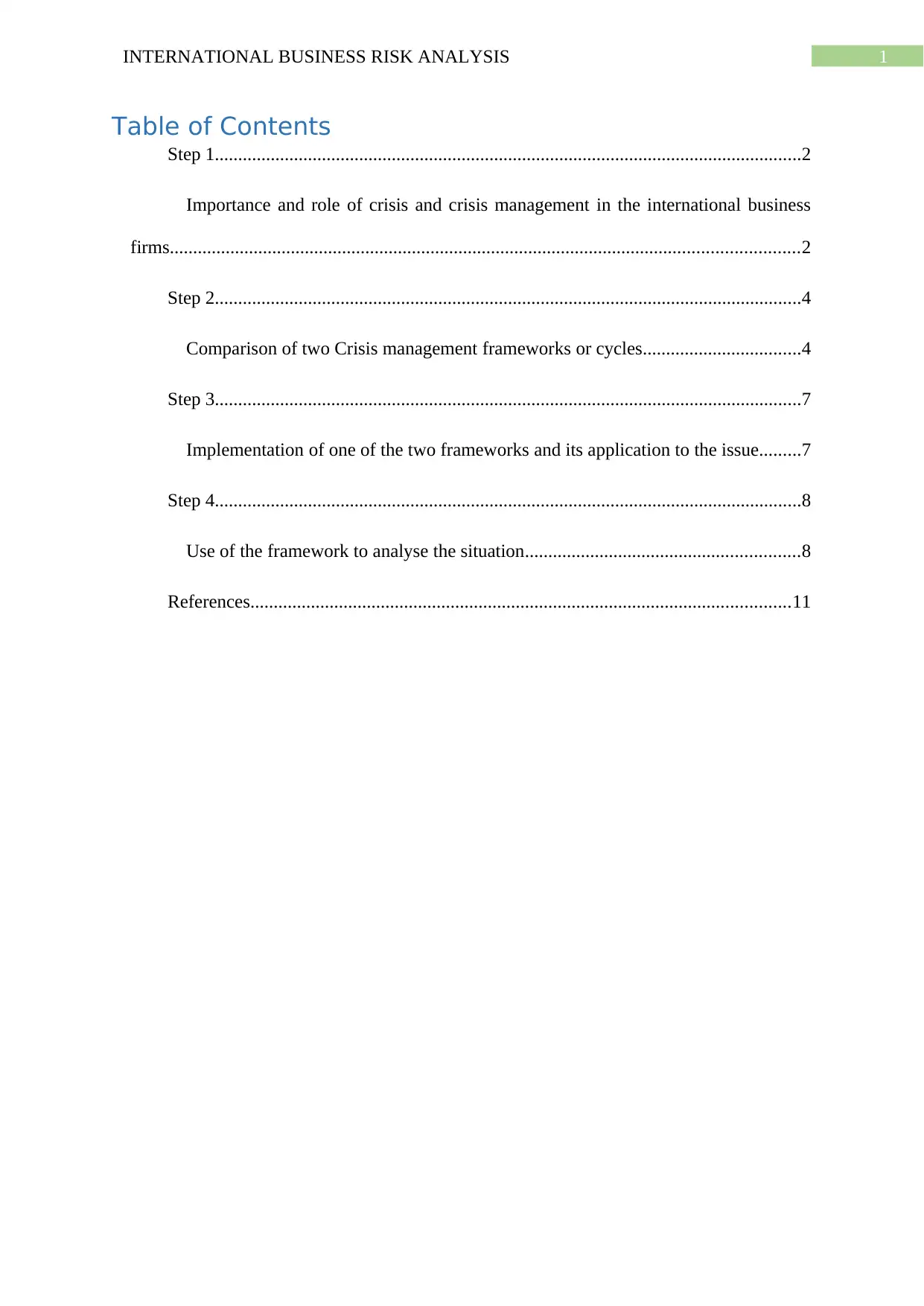
1INTERNATIONAL BUSINESS RISK ANALYSIS
Table of Contents
Step 1..............................................................................................................................2
Importance and role of crisis and crisis management in the international business
firms.......................................................................................................................................2
Step 2..............................................................................................................................4
Comparison of two Crisis management frameworks or cycles..................................4
Step 3..............................................................................................................................7
Implementation of one of the two frameworks and its application to the issue.........7
Step 4..............................................................................................................................8
Use of the framework to analyse the situation...........................................................8
References....................................................................................................................11
Table of Contents
Step 1..............................................................................................................................2
Importance and role of crisis and crisis management in the international business
firms.......................................................................................................................................2
Step 2..............................................................................................................................4
Comparison of two Crisis management frameworks or cycles..................................4
Step 3..............................................................................................................................7
Implementation of one of the two frameworks and its application to the issue.........7
Step 4..............................................................................................................................8
Use of the framework to analyse the situation...........................................................8
References....................................................................................................................11
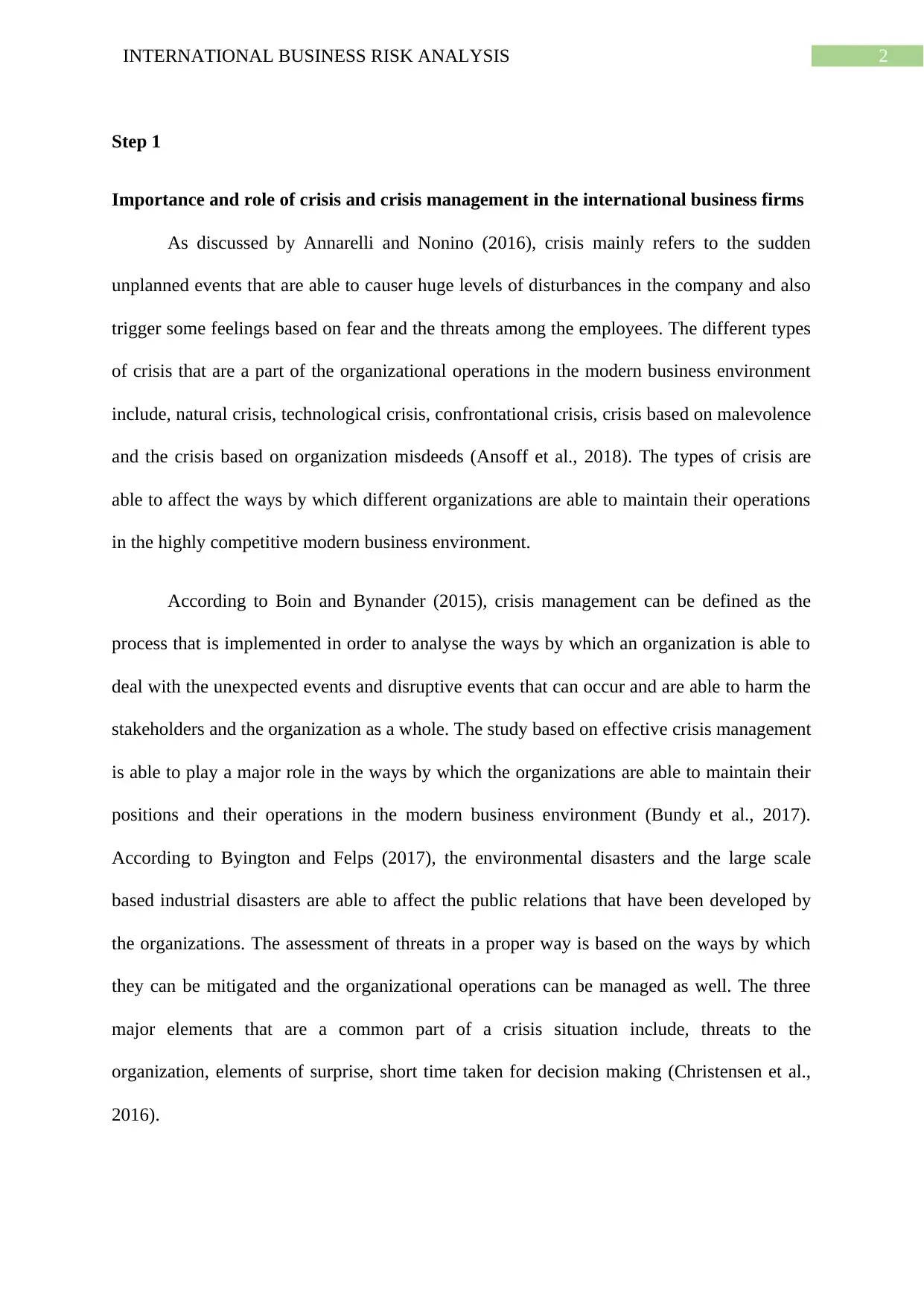
2INTERNATIONAL BUSINESS RISK ANALYSIS
Step 1
Importance and role of crisis and crisis management in the international business firms
As discussed by Annarelli and Nonino (2016), crisis mainly refers to the sudden
unplanned events that are able to causer huge levels of disturbances in the company and also
trigger some feelings based on fear and the threats among the employees. The different types
of crisis that are a part of the organizational operations in the modern business environment
include, natural crisis, technological crisis, confrontational crisis, crisis based on malevolence
and the crisis based on organization misdeeds (Ansoff et al., 2018). The types of crisis are
able to affect the ways by which different organizations are able to maintain their operations
in the highly competitive modern business environment.
According to Boin and Bynander (2015), crisis management can be defined as the
process that is implemented in order to analyse the ways by which an organization is able to
deal with the unexpected events and disruptive events that can occur and are able to harm the
stakeholders and the organization as a whole. The study based on effective crisis management
is able to play a major role in the ways by which the organizations are able to maintain their
positions and their operations in the modern business environment (Bundy et al., 2017).
According to Byington and Felps (2017), the environmental disasters and the large scale
based industrial disasters are able to affect the public relations that have been developed by
the organizations. The assessment of threats in a proper way is based on the ways by which
they can be mitigated and the organizational operations can be managed as well. The three
major elements that are a common part of a crisis situation include, threats to the
organization, elements of surprise, short time taken for decision making (Christensen et al.,
2016).
Step 1
Importance and role of crisis and crisis management in the international business firms
As discussed by Annarelli and Nonino (2016), crisis mainly refers to the sudden
unplanned events that are able to causer huge levels of disturbances in the company and also
trigger some feelings based on fear and the threats among the employees. The different types
of crisis that are a part of the organizational operations in the modern business environment
include, natural crisis, technological crisis, confrontational crisis, crisis based on malevolence
and the crisis based on organization misdeeds (Ansoff et al., 2018). The types of crisis are
able to affect the ways by which different organizations are able to maintain their operations
in the highly competitive modern business environment.
According to Boin and Bynander (2015), crisis management can be defined as the
process that is implemented in order to analyse the ways by which an organization is able to
deal with the unexpected events and disruptive events that can occur and are able to harm the
stakeholders and the organization as a whole. The study based on effective crisis management
is able to play a major role in the ways by which the organizations are able to maintain their
positions and their operations in the modern business environment (Bundy et al., 2017).
According to Byington and Felps (2017), the environmental disasters and the large scale
based industrial disasters are able to affect the public relations that have been developed by
the organizations. The assessment of threats in a proper way is based on the ways by which
they can be mitigated and the organizational operations can be managed as well. The three
major elements that are a common part of a crisis situation include, threats to the
organization, elements of surprise, short time taken for decision making (Christensen et al.,
2016).
⊘ This is a preview!⊘
Do you want full access?
Subscribe today to unlock all pages.

Trusted by 1+ million students worldwide
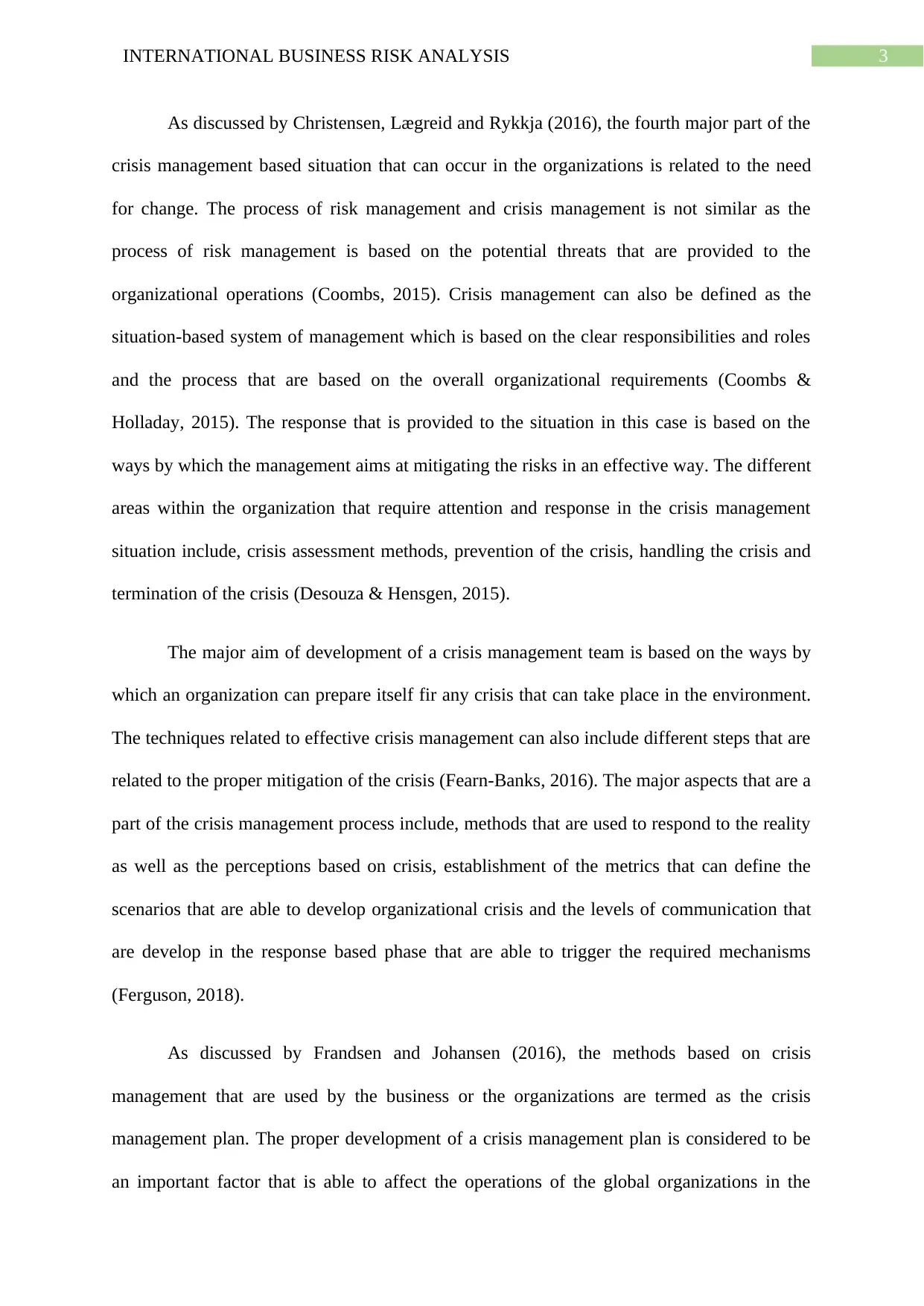
3INTERNATIONAL BUSINESS RISK ANALYSIS
As discussed by Christensen, Lægreid and Rykkja (2016), the fourth major part of the
crisis management based situation that can occur in the organizations is related to the need
for change. The process of risk management and crisis management is not similar as the
process of risk management is based on the potential threats that are provided to the
organizational operations (Coombs, 2015). Crisis management can also be defined as the
situation-based system of management which is based on the clear responsibilities and roles
and the process that are based on the overall organizational requirements (Coombs &
Holladay, 2015). The response that is provided to the situation in this case is based on the
ways by which the management aims at mitigating the risks in an effective way. The different
areas within the organization that require attention and response in the crisis management
situation include, crisis assessment methods, prevention of the crisis, handling the crisis and
termination of the crisis (Desouza & Hensgen, 2015).
The major aim of development of a crisis management team is based on the ways by
which an organization can prepare itself fir any crisis that can take place in the environment.
The techniques related to effective crisis management can also include different steps that are
related to the proper mitigation of the crisis (Fearn-Banks, 2016). The major aspects that are a
part of the crisis management process include, methods that are used to respond to the reality
as well as the perceptions based on crisis, establishment of the metrics that can define the
scenarios that are able to develop organizational crisis and the levels of communication that
are develop in the response based phase that are able to trigger the required mechanisms
(Ferguson, 2018).
As discussed by Frandsen and Johansen (2016), the methods based on crisis
management that are used by the business or the organizations are termed as the crisis
management plan. The proper development of a crisis management plan is considered to be
an important factor that is able to affect the operations of the global organizations in the
As discussed by Christensen, Lægreid and Rykkja (2016), the fourth major part of the
crisis management based situation that can occur in the organizations is related to the need
for change. The process of risk management and crisis management is not similar as the
process of risk management is based on the potential threats that are provided to the
organizational operations (Coombs, 2015). Crisis management can also be defined as the
situation-based system of management which is based on the clear responsibilities and roles
and the process that are based on the overall organizational requirements (Coombs &
Holladay, 2015). The response that is provided to the situation in this case is based on the
ways by which the management aims at mitigating the risks in an effective way. The different
areas within the organization that require attention and response in the crisis management
situation include, crisis assessment methods, prevention of the crisis, handling the crisis and
termination of the crisis (Desouza & Hensgen, 2015).
The major aim of development of a crisis management team is based on the ways by
which an organization can prepare itself fir any crisis that can take place in the environment.
The techniques related to effective crisis management can also include different steps that are
related to the proper mitigation of the crisis (Fearn-Banks, 2016). The major aspects that are a
part of the crisis management process include, methods that are used to respond to the reality
as well as the perceptions based on crisis, establishment of the metrics that can define the
scenarios that are able to develop organizational crisis and the levels of communication that
are develop in the response based phase that are able to trigger the required mechanisms
(Ferguson, 2018).
As discussed by Frandsen and Johansen (2016), the methods based on crisis
management that are used by the business or the organizations are termed as the crisis
management plan. The proper development of a crisis management plan is considered to be
an important factor that is able to affect the operations of the global organizations in the
Paraphrase This Document
Need a fresh take? Get an instant paraphrase of this document with our AI Paraphraser
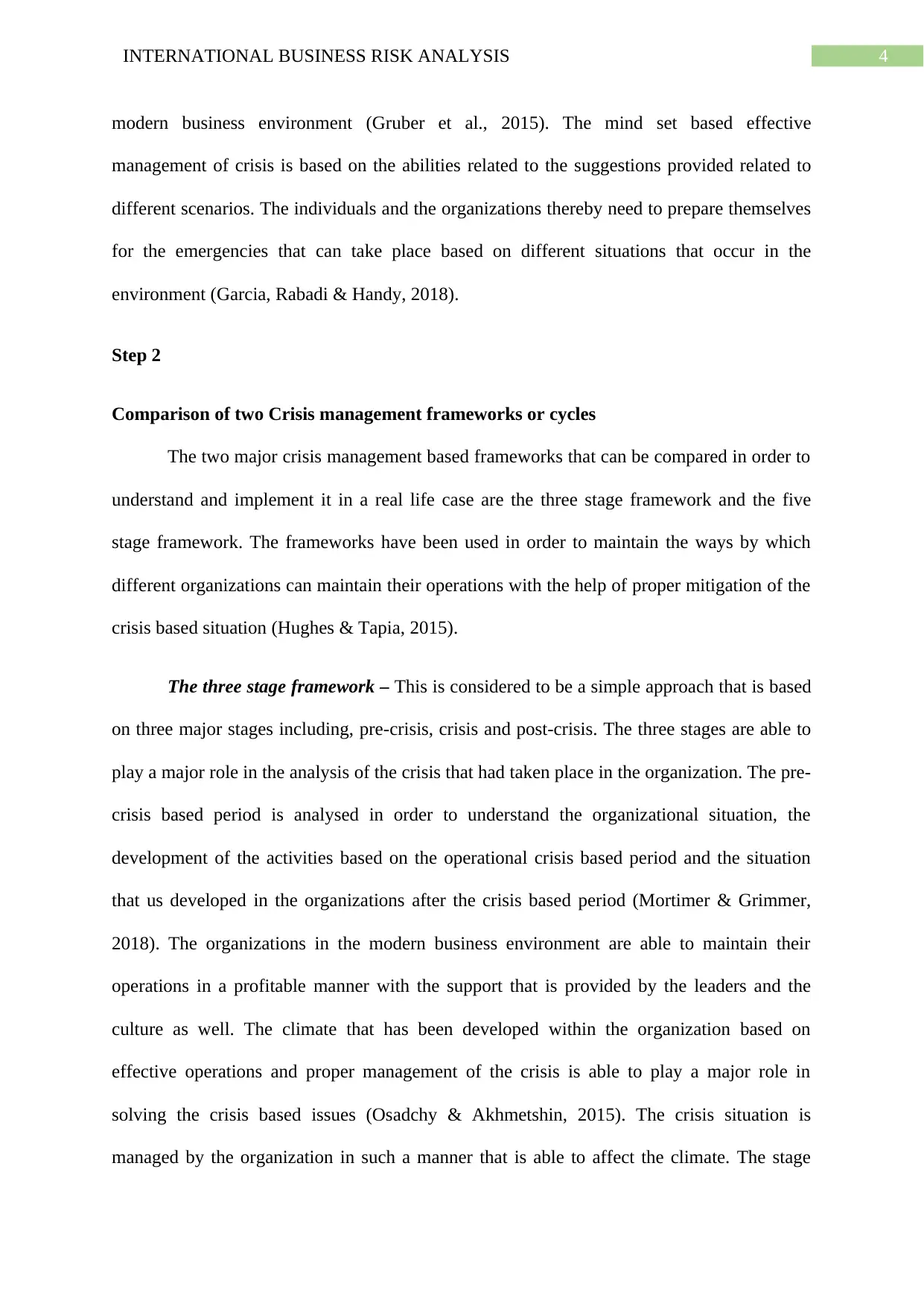
4INTERNATIONAL BUSINESS RISK ANALYSIS
modern business environment (Gruber et al., 2015). The mind set based effective
management of crisis is based on the abilities related to the suggestions provided related to
different scenarios. The individuals and the organizations thereby need to prepare themselves
for the emergencies that can take place based on different situations that occur in the
environment (Garcia, Rabadi & Handy, 2018).
Step 2
Comparison of two Crisis management frameworks or cycles
The two major crisis management based frameworks that can be compared in order to
understand and implement it in a real life case are the three stage framework and the five
stage framework. The frameworks have been used in order to maintain the ways by which
different organizations can maintain their operations with the help of proper mitigation of the
crisis based situation (Hughes & Tapia, 2015).
The three stage framework – This is considered to be a simple approach that is based
on three major stages including, pre-crisis, crisis and post-crisis. The three stages are able to
play a major role in the analysis of the crisis that had taken place in the organization. The pre-
crisis based period is analysed in order to understand the organizational situation, the
development of the activities based on the operational crisis based period and the situation
that us developed in the organizations after the crisis based period (Mortimer & Grimmer,
2018). The organizations in the modern business environment are able to maintain their
operations in a profitable manner with the support that is provided by the leaders and the
culture as well. The climate that has been developed within the organization based on
effective operations and proper management of the crisis is able to play a major role in
solving the crisis based issues (Osadchy & Akhmetshin, 2015). The crisis situation is
managed by the organization in such a manner that is able to affect the climate. The stage
modern business environment (Gruber et al., 2015). The mind set based effective
management of crisis is based on the abilities related to the suggestions provided related to
different scenarios. The individuals and the organizations thereby need to prepare themselves
for the emergencies that can take place based on different situations that occur in the
environment (Garcia, Rabadi & Handy, 2018).
Step 2
Comparison of two Crisis management frameworks or cycles
The two major crisis management based frameworks that can be compared in order to
understand and implement it in a real life case are the three stage framework and the five
stage framework. The frameworks have been used in order to maintain the ways by which
different organizations can maintain their operations with the help of proper mitigation of the
crisis based situation (Hughes & Tapia, 2015).
The three stage framework – This is considered to be a simple approach that is based
on three major stages including, pre-crisis, crisis and post-crisis. The three stages are able to
play a major role in the analysis of the crisis that had taken place in the organization. The pre-
crisis based period is analysed in order to understand the organizational situation, the
development of the activities based on the operational crisis based period and the situation
that us developed in the organizations after the crisis based period (Mortimer & Grimmer,
2018). The organizations in the modern business environment are able to maintain their
operations in a profitable manner with the support that is provided by the leaders and the
culture as well. The climate that has been developed within the organization based on
effective operations and proper management of the crisis is able to play a major role in
solving the crisis based issues (Osadchy & Akhmetshin, 2015). The crisis situation is
managed by the organization in such a manner that is able to affect the climate. The stage
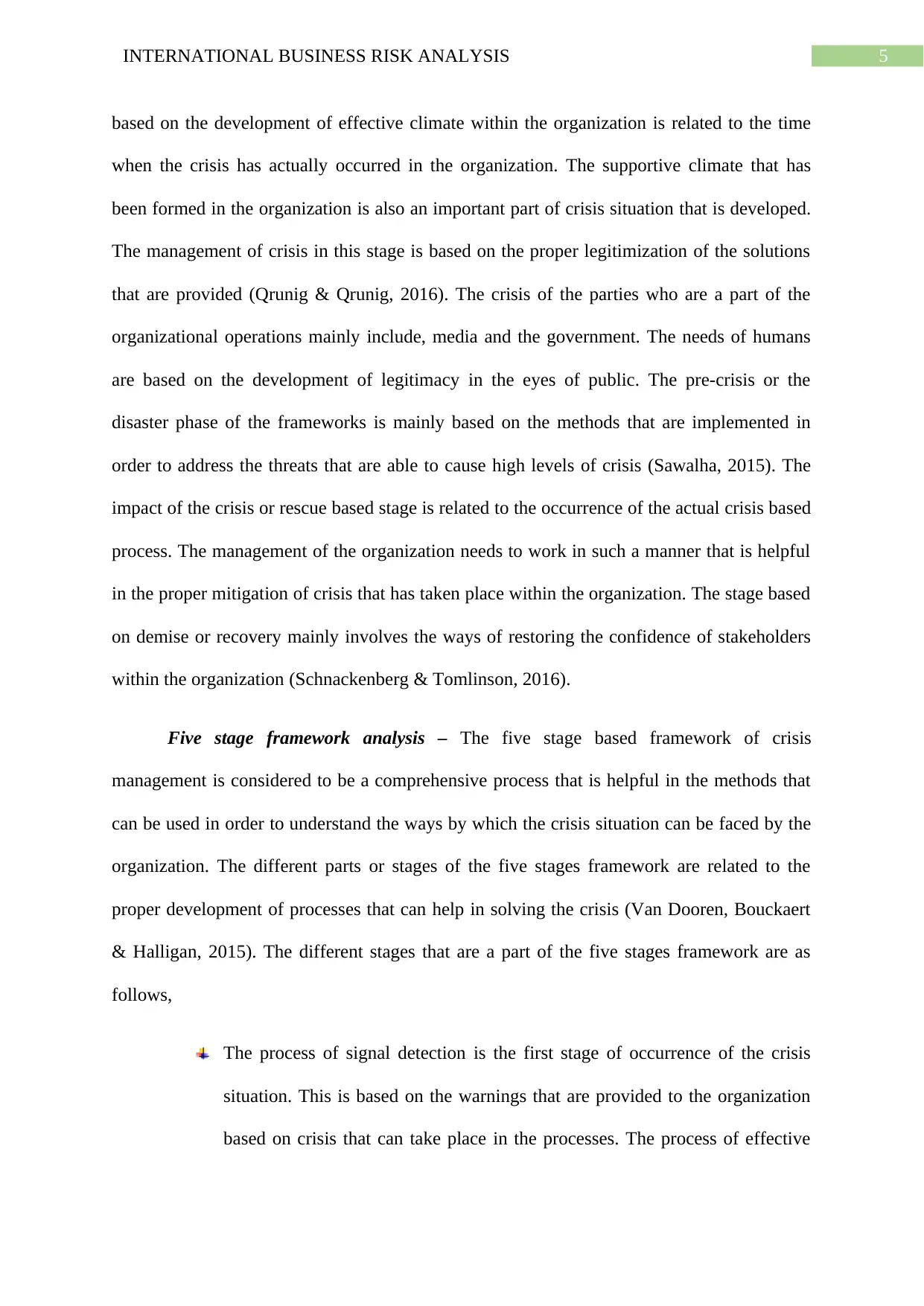
5INTERNATIONAL BUSINESS RISK ANALYSIS
based on the development of effective climate within the organization is related to the time
when the crisis has actually occurred in the organization. The supportive climate that has
been formed in the organization is also an important part of crisis situation that is developed.
The management of crisis in this stage is based on the proper legitimization of the solutions
that are provided (Qrunig & Qrunig, 2016). The crisis of the parties who are a part of the
organizational operations mainly include, media and the government. The needs of humans
are based on the development of legitimacy in the eyes of public. The pre-crisis or the
disaster phase of the frameworks is mainly based on the methods that are implemented in
order to address the threats that are able to cause high levels of crisis (Sawalha, 2015). The
impact of the crisis or rescue based stage is related to the occurrence of the actual crisis based
process. The management of the organization needs to work in such a manner that is helpful
in the proper mitigation of crisis that has taken place within the organization. The stage based
on demise or recovery mainly involves the ways of restoring the confidence of stakeholders
within the organization (Schnackenberg & Tomlinson, 2016).
Five stage framework analysis – The five stage based framework of crisis
management is considered to be a comprehensive process that is helpful in the methods that
can be used in order to understand the ways by which the crisis situation can be faced by the
organization. The different parts or stages of the five stages framework are related to the
proper development of processes that can help in solving the crisis (Van Dooren, Bouckaert
& Halligan, 2015). The different stages that are a part of the five stages framework are as
follows,
The process of signal detection is the first stage of occurrence of the crisis
situation. This is based on the warnings that are provided to the organization
based on crisis that can take place in the processes. The process of effective
based on the development of effective climate within the organization is related to the time
when the crisis has actually occurred in the organization. The supportive climate that has
been formed in the organization is also an important part of crisis situation that is developed.
The management of crisis in this stage is based on the proper legitimization of the solutions
that are provided (Qrunig & Qrunig, 2016). The crisis of the parties who are a part of the
organizational operations mainly include, media and the government. The needs of humans
are based on the development of legitimacy in the eyes of public. The pre-crisis or the
disaster phase of the frameworks is mainly based on the methods that are implemented in
order to address the threats that are able to cause high levels of crisis (Sawalha, 2015). The
impact of the crisis or rescue based stage is related to the occurrence of the actual crisis based
process. The management of the organization needs to work in such a manner that is helpful
in the proper mitigation of crisis that has taken place within the organization. The stage based
on demise or recovery mainly involves the ways of restoring the confidence of stakeholders
within the organization (Schnackenberg & Tomlinson, 2016).
Five stage framework analysis – The five stage based framework of crisis
management is considered to be a comprehensive process that is helpful in the methods that
can be used in order to understand the ways by which the crisis situation can be faced by the
organization. The different parts or stages of the five stages framework are related to the
proper development of processes that can help in solving the crisis (Van Dooren, Bouckaert
& Halligan, 2015). The different stages that are a part of the five stages framework are as
follows,
The process of signal detection is the first stage of occurrence of the crisis
situation. This is based on the warnings that are provided to the organization
based on crisis that can take place in the processes. The process of effective
⊘ This is a preview!⊘
Do you want full access?
Subscribe today to unlock all pages.

Trusted by 1+ million students worldwide
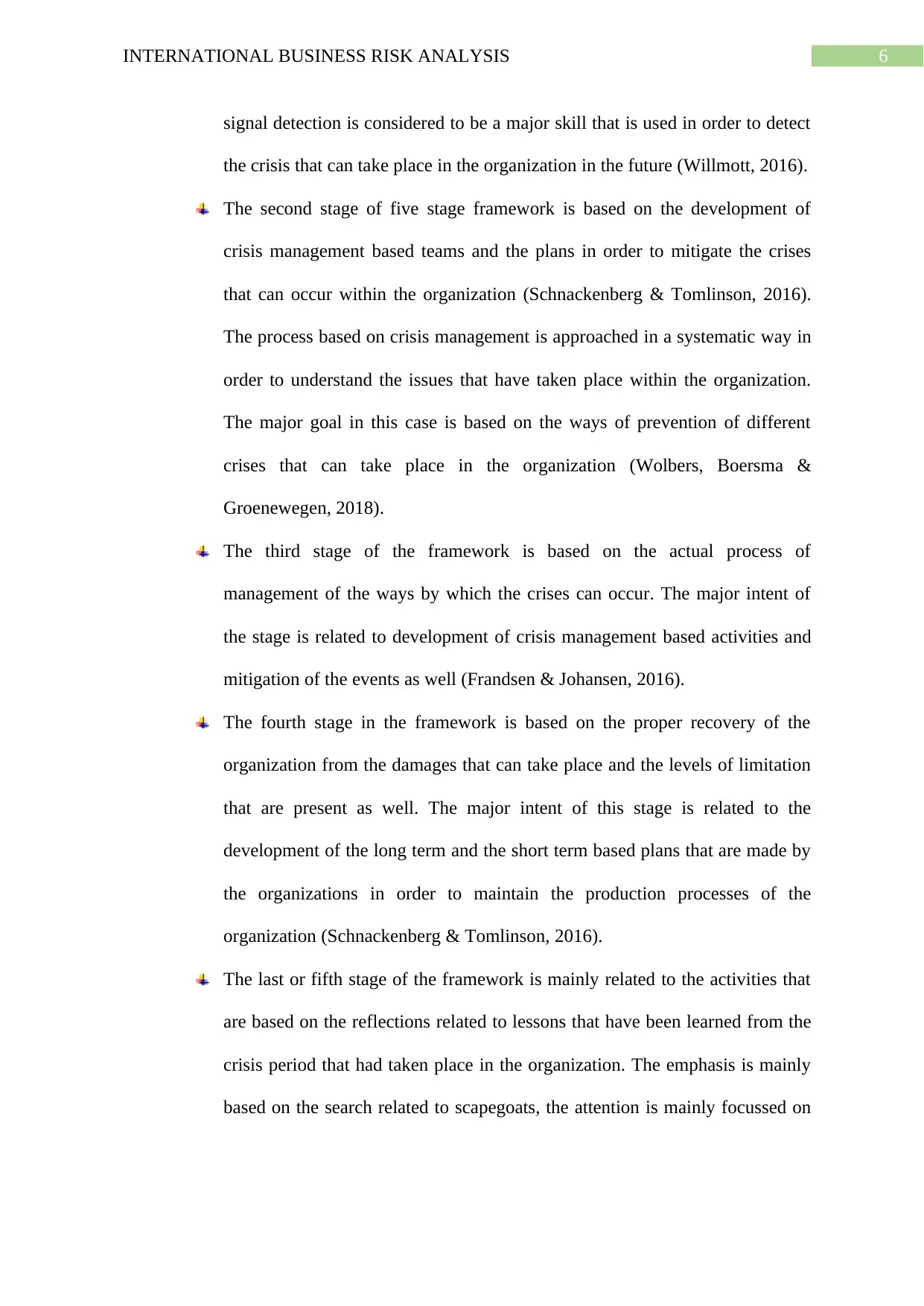
6INTERNATIONAL BUSINESS RISK ANALYSIS
signal detection is considered to be a major skill that is used in order to detect
the crisis that can take place in the organization in the future (Willmott, 2016).
The second stage of five stage framework is based on the development of
crisis management based teams and the plans in order to mitigate the crises
that can occur within the organization (Schnackenberg & Tomlinson, 2016).
The process based on crisis management is approached in a systematic way in
order to understand the issues that have taken place within the organization.
The major goal in this case is based on the ways of prevention of different
crises that can take place in the organization (Wolbers, Boersma &
Groenewegen, 2018).
The third stage of the framework is based on the actual process of
management of the ways by which the crises can occur. The major intent of
the stage is related to development of crisis management based activities and
mitigation of the events as well (Frandsen & Johansen, 2016).
The fourth stage in the framework is based on the proper recovery of the
organization from the damages that can take place and the levels of limitation
that are present as well. The major intent of this stage is related to the
development of the long term and the short term based plans that are made by
the organizations in order to maintain the production processes of the
organization (Schnackenberg & Tomlinson, 2016).
The last or fifth stage of the framework is mainly related to the activities that
are based on the reflections related to lessons that have been learned from the
crisis period that had taken place in the organization. The emphasis is mainly
based on the search related to scapegoats, the attention is mainly focussed on
signal detection is considered to be a major skill that is used in order to detect
the crisis that can take place in the organization in the future (Willmott, 2016).
The second stage of five stage framework is based on the development of
crisis management based teams and the plans in order to mitigate the crises
that can occur within the organization (Schnackenberg & Tomlinson, 2016).
The process based on crisis management is approached in a systematic way in
order to understand the issues that have taken place within the organization.
The major goal in this case is based on the ways of prevention of different
crises that can take place in the organization (Wolbers, Boersma &
Groenewegen, 2018).
The third stage of the framework is based on the actual process of
management of the ways by which the crises can occur. The major intent of
the stage is related to development of crisis management based activities and
mitigation of the events as well (Frandsen & Johansen, 2016).
The fourth stage in the framework is based on the proper recovery of the
organization from the damages that can take place and the levels of limitation
that are present as well. The major intent of this stage is related to the
development of the long term and the short term based plans that are made by
the organizations in order to maintain the production processes of the
organization (Schnackenberg & Tomlinson, 2016).
The last or fifth stage of the framework is mainly related to the activities that
are based on the reflections related to lessons that have been learned from the
crisis period that had taken place in the organization. The emphasis is mainly
based on the search related to scapegoats, the attention is mainly focussed on
Paraphrase This Document
Need a fresh take? Get an instant paraphrase of this document with our AI Paraphraser
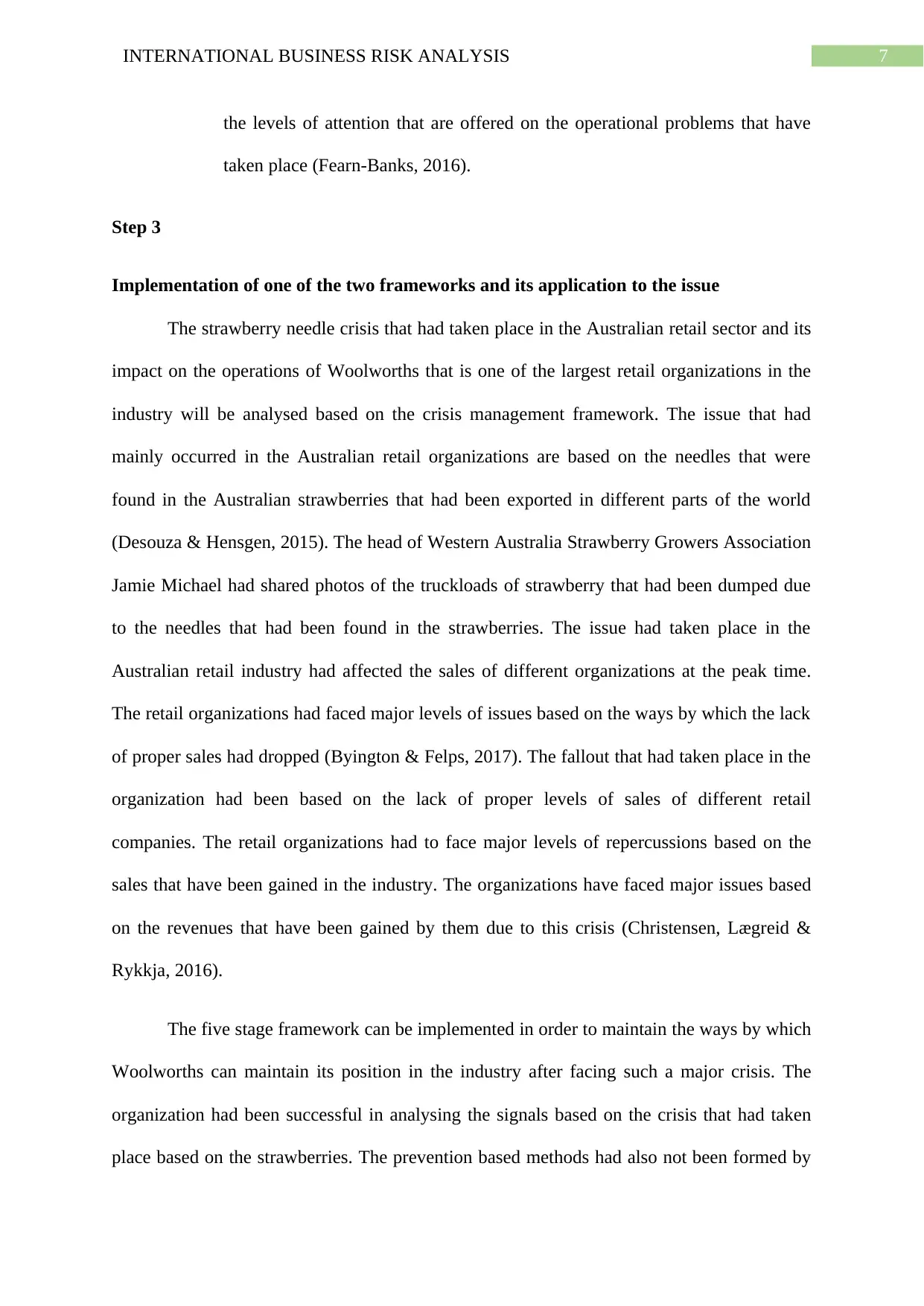
7INTERNATIONAL BUSINESS RISK ANALYSIS
the levels of attention that are offered on the operational problems that have
taken place (Fearn-Banks, 2016).
Step 3
Implementation of one of the two frameworks and its application to the issue
The strawberry needle crisis that had taken place in the Australian retail sector and its
impact on the operations of Woolworths that is one of the largest retail organizations in the
industry will be analysed based on the crisis management framework. The issue that had
mainly occurred in the Australian retail organizations are based on the needles that were
found in the Australian strawberries that had been exported in different parts of the world
(Desouza & Hensgen, 2015). The head of Western Australia Strawberry Growers Association
Jamie Michael had shared photos of the truckloads of strawberry that had been dumped due
to the needles that had been found in the strawberries. The issue had taken place in the
Australian retail industry had affected the sales of different organizations at the peak time.
The retail organizations had faced major levels of issues based on the ways by which the lack
of proper sales had dropped (Byington & Felps, 2017). The fallout that had taken place in the
organization had been based on the lack of proper levels of sales of different retail
companies. The retail organizations had to face major levels of repercussions based on the
sales that have been gained in the industry. The organizations have faced major issues based
on the revenues that have been gained by them due to this crisis (Christensen, Lægreid &
Rykkja, 2016).
The five stage framework can be implemented in order to maintain the ways by which
Woolworths can maintain its position in the industry after facing such a major crisis. The
organization had been successful in analysing the signals based on the crisis that had taken
place based on the strawberries. The prevention based methods had also not been formed by
the levels of attention that are offered on the operational problems that have
taken place (Fearn-Banks, 2016).
Step 3
Implementation of one of the two frameworks and its application to the issue
The strawberry needle crisis that had taken place in the Australian retail sector and its
impact on the operations of Woolworths that is one of the largest retail organizations in the
industry will be analysed based on the crisis management framework. The issue that had
mainly occurred in the Australian retail organizations are based on the needles that were
found in the Australian strawberries that had been exported in different parts of the world
(Desouza & Hensgen, 2015). The head of Western Australia Strawberry Growers Association
Jamie Michael had shared photos of the truckloads of strawberry that had been dumped due
to the needles that had been found in the strawberries. The issue had taken place in the
Australian retail industry had affected the sales of different organizations at the peak time.
The retail organizations had faced major levels of issues based on the ways by which the lack
of proper sales had dropped (Byington & Felps, 2017). The fallout that had taken place in the
organization had been based on the lack of proper levels of sales of different retail
companies. The retail organizations had to face major levels of repercussions based on the
sales that have been gained in the industry. The organizations have faced major issues based
on the revenues that have been gained by them due to this crisis (Christensen, Lægreid &
Rykkja, 2016).
The five stage framework can be implemented in order to maintain the ways by which
Woolworths can maintain its position in the industry after facing such a major crisis. The
organization had been successful in analysing the signals based on the crisis that had taken
place based on the strawberries. The prevention based methods had also not been formed by
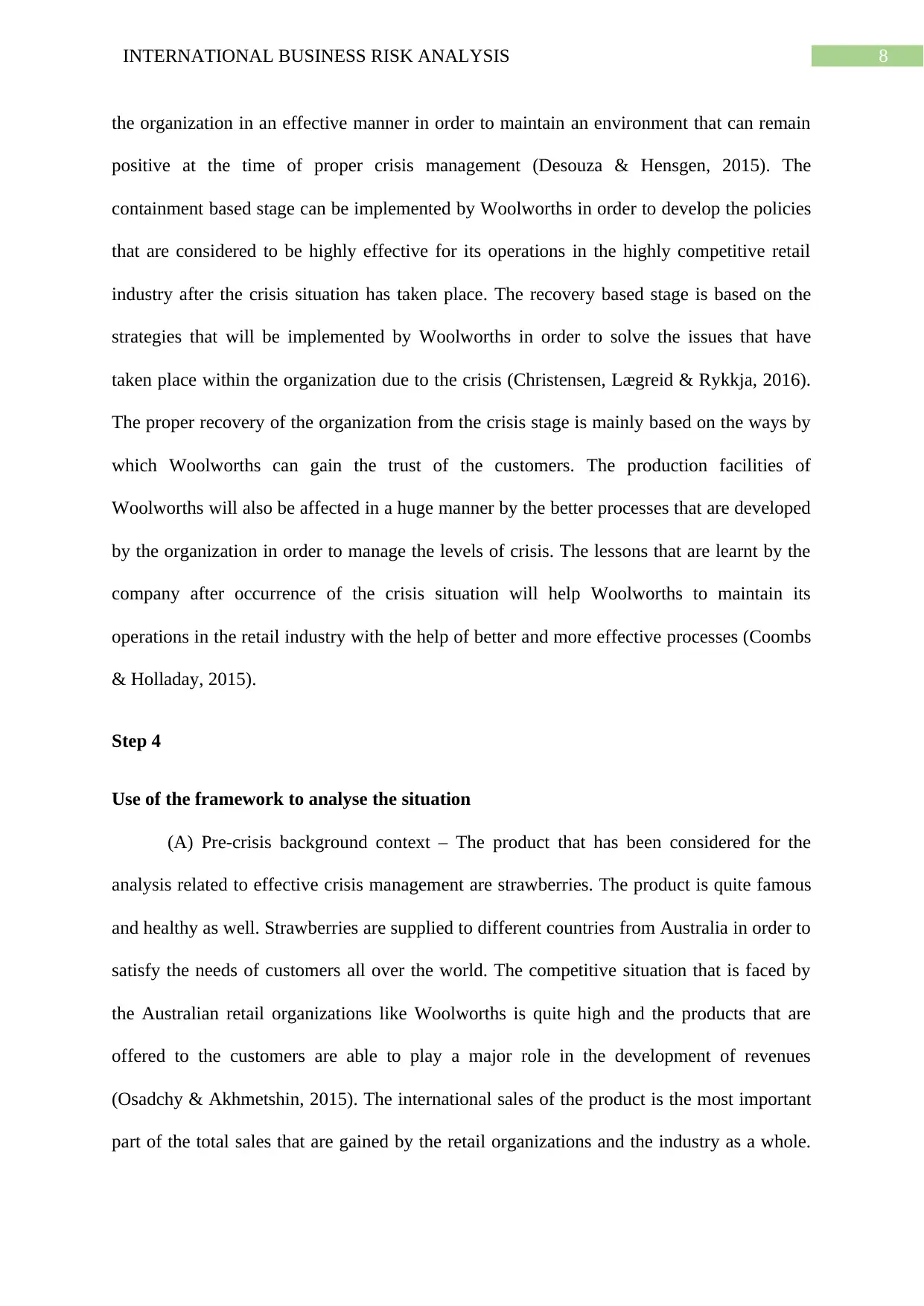
8INTERNATIONAL BUSINESS RISK ANALYSIS
the organization in an effective manner in order to maintain an environment that can remain
positive at the time of proper crisis management (Desouza & Hensgen, 2015). The
containment based stage can be implemented by Woolworths in order to develop the policies
that are considered to be highly effective for its operations in the highly competitive retail
industry after the crisis situation has taken place. The recovery based stage is based on the
strategies that will be implemented by Woolworths in order to solve the issues that have
taken place within the organization due to the crisis (Christensen, Lægreid & Rykkja, 2016).
The proper recovery of the organization from the crisis stage is mainly based on the ways by
which Woolworths can gain the trust of the customers. The production facilities of
Woolworths will also be affected in a huge manner by the better processes that are developed
by the organization in order to manage the levels of crisis. The lessons that are learnt by the
company after occurrence of the crisis situation will help Woolworths to maintain its
operations in the retail industry with the help of better and more effective processes (Coombs
& Holladay, 2015).
Step 4
Use of the framework to analyse the situation
(A) Pre-crisis background context – The product that has been considered for the
analysis related to effective crisis management are strawberries. The product is quite famous
and healthy as well. Strawberries are supplied to different countries from Australia in order to
satisfy the needs of customers all over the world. The competitive situation that is faced by
the Australian retail organizations like Woolworths is quite high and the products that are
offered to the customers are able to play a major role in the development of revenues
(Osadchy & Akhmetshin, 2015). The international sales of the product is the most important
part of the total sales that are gained by the retail organizations and the industry as a whole.
the organization in an effective manner in order to maintain an environment that can remain
positive at the time of proper crisis management (Desouza & Hensgen, 2015). The
containment based stage can be implemented by Woolworths in order to develop the policies
that are considered to be highly effective for its operations in the highly competitive retail
industry after the crisis situation has taken place. The recovery based stage is based on the
strategies that will be implemented by Woolworths in order to solve the issues that have
taken place within the organization due to the crisis (Christensen, Lægreid & Rykkja, 2016).
The proper recovery of the organization from the crisis stage is mainly based on the ways by
which Woolworths can gain the trust of the customers. The production facilities of
Woolworths will also be affected in a huge manner by the better processes that are developed
by the organization in order to manage the levels of crisis. The lessons that are learnt by the
company after occurrence of the crisis situation will help Woolworths to maintain its
operations in the retail industry with the help of better and more effective processes (Coombs
& Holladay, 2015).
Step 4
Use of the framework to analyse the situation
(A) Pre-crisis background context – The product that has been considered for the
analysis related to effective crisis management are strawberries. The product is quite famous
and healthy as well. Strawberries are supplied to different countries from Australia in order to
satisfy the needs of customers all over the world. The competitive situation that is faced by
the Australian retail organizations like Woolworths is quite high and the products that are
offered to the customers are able to play a major role in the development of revenues
(Osadchy & Akhmetshin, 2015). The international sales of the product is the most important
part of the total sales that are gained by the retail organizations and the industry as a whole.
⊘ This is a preview!⊘
Do you want full access?
Subscribe today to unlock all pages.

Trusted by 1+ million students worldwide
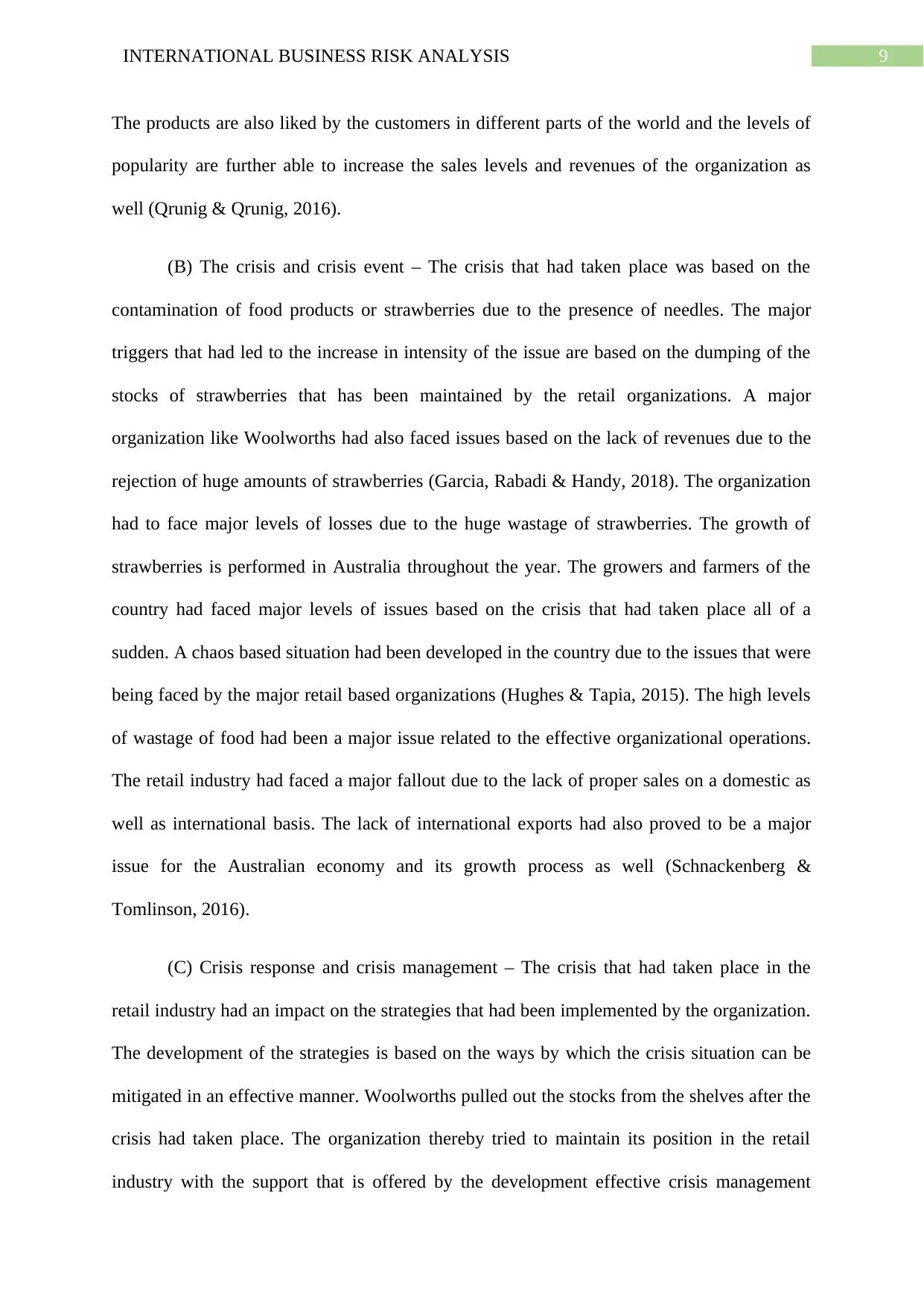
9INTERNATIONAL BUSINESS RISK ANALYSIS
The products are also liked by the customers in different parts of the world and the levels of
popularity are further able to increase the sales levels and revenues of the organization as
well (Qrunig & Qrunig, 2016).
(B) The crisis and crisis event – The crisis that had taken place was based on the
contamination of food products or strawberries due to the presence of needles. The major
triggers that had led to the increase in intensity of the issue are based on the dumping of the
stocks of strawberries that has been maintained by the retail organizations. A major
organization like Woolworths had also faced issues based on the lack of revenues due to the
rejection of huge amounts of strawberries (Garcia, Rabadi & Handy, 2018). The organization
had to face major levels of losses due to the huge wastage of strawberries. The growth of
strawberries is performed in Australia throughout the year. The growers and farmers of the
country had faced major levels of issues based on the crisis that had taken place all of a
sudden. A chaos based situation had been developed in the country due to the issues that were
being faced by the major retail based organizations (Hughes & Tapia, 2015). The high levels
of wastage of food had been a major issue related to the effective organizational operations.
The retail industry had faced a major fallout due to the lack of proper sales on a domestic as
well as international basis. The lack of international exports had also proved to be a major
issue for the Australian economy and its growth process as well (Schnackenberg &
Tomlinson, 2016).
(C) Crisis response and crisis management – The crisis that had taken place in the
retail industry had an impact on the strategies that had been implemented by the organization.
The development of the strategies is based on the ways by which the crisis situation can be
mitigated in an effective manner. Woolworths pulled out the stocks from the shelves after the
crisis had taken place. The organization thereby tried to maintain its position in the retail
industry with the support that is offered by the development effective crisis management
The products are also liked by the customers in different parts of the world and the levels of
popularity are further able to increase the sales levels and revenues of the organization as
well (Qrunig & Qrunig, 2016).
(B) The crisis and crisis event – The crisis that had taken place was based on the
contamination of food products or strawberries due to the presence of needles. The major
triggers that had led to the increase in intensity of the issue are based on the dumping of the
stocks of strawberries that has been maintained by the retail organizations. A major
organization like Woolworths had also faced issues based on the lack of revenues due to the
rejection of huge amounts of strawberries (Garcia, Rabadi & Handy, 2018). The organization
had to face major levels of losses due to the huge wastage of strawberries. The growth of
strawberries is performed in Australia throughout the year. The growers and farmers of the
country had faced major levels of issues based on the crisis that had taken place all of a
sudden. A chaos based situation had been developed in the country due to the issues that were
being faced by the major retail based organizations (Hughes & Tapia, 2015). The high levels
of wastage of food had been a major issue related to the effective organizational operations.
The retail industry had faced a major fallout due to the lack of proper sales on a domestic as
well as international basis. The lack of international exports had also proved to be a major
issue for the Australian economy and its growth process as well (Schnackenberg &
Tomlinson, 2016).
(C) Crisis response and crisis management – The crisis that had taken place in the
retail industry had an impact on the strategies that had been implemented by the organization.
The development of the strategies is based on the ways by which the crisis situation can be
mitigated in an effective manner. Woolworths pulled out the stocks from the shelves after the
crisis had taken place. The organization thereby tried to maintain its position in the retail
industry with the support that is offered by the development effective crisis management
Paraphrase This Document
Need a fresh take? Get an instant paraphrase of this document with our AI Paraphraser
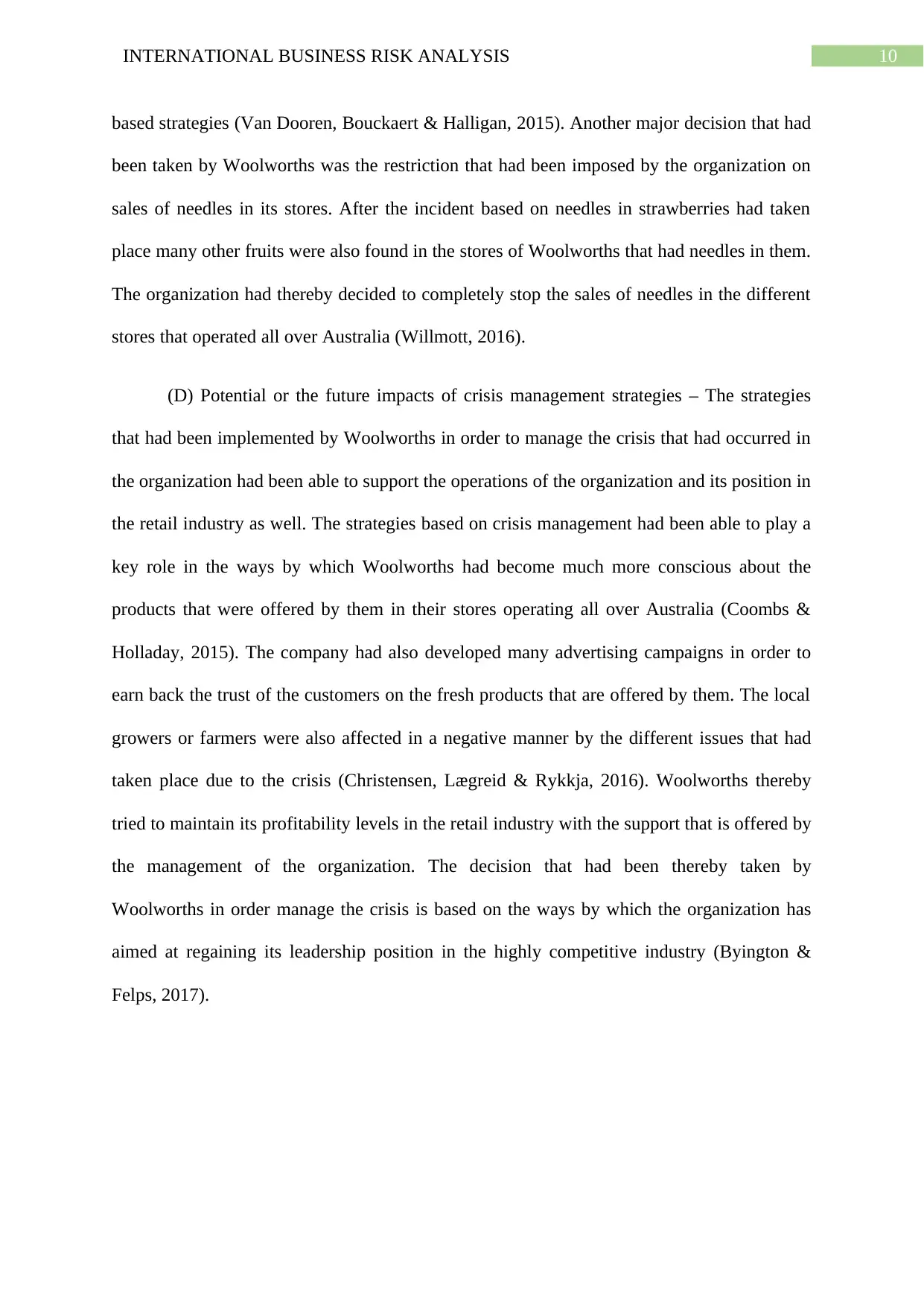
10INTERNATIONAL BUSINESS RISK ANALYSIS
based strategies (Van Dooren, Bouckaert & Halligan, 2015). Another major decision that had
been taken by Woolworths was the restriction that had been imposed by the organization on
sales of needles in its stores. After the incident based on needles in strawberries had taken
place many other fruits were also found in the stores of Woolworths that had needles in them.
The organization had thereby decided to completely stop the sales of needles in the different
stores that operated all over Australia (Willmott, 2016).
(D) Potential or the future impacts of crisis management strategies – The strategies
that had been implemented by Woolworths in order to manage the crisis that had occurred in
the organization had been able to support the operations of the organization and its position in
the retail industry as well. The strategies based on crisis management had been able to play a
key role in the ways by which Woolworths had become much more conscious about the
products that were offered by them in their stores operating all over Australia (Coombs &
Holladay, 2015). The company had also developed many advertising campaigns in order to
earn back the trust of the customers on the fresh products that are offered by them. The local
growers or farmers were also affected in a negative manner by the different issues that had
taken place due to the crisis (Christensen, Lægreid & Rykkja, 2016). Woolworths thereby
tried to maintain its profitability levels in the retail industry with the support that is offered by
the management of the organization. The decision that had been thereby taken by
Woolworths in order manage the crisis is based on the ways by which the organization has
aimed at regaining its leadership position in the highly competitive industry (Byington &
Felps, 2017).
based strategies (Van Dooren, Bouckaert & Halligan, 2015). Another major decision that had
been taken by Woolworths was the restriction that had been imposed by the organization on
sales of needles in its stores. After the incident based on needles in strawberries had taken
place many other fruits were also found in the stores of Woolworths that had needles in them.
The organization had thereby decided to completely stop the sales of needles in the different
stores that operated all over Australia (Willmott, 2016).
(D) Potential or the future impacts of crisis management strategies – The strategies
that had been implemented by Woolworths in order to manage the crisis that had occurred in
the organization had been able to support the operations of the organization and its position in
the retail industry as well. The strategies based on crisis management had been able to play a
key role in the ways by which Woolworths had become much more conscious about the
products that were offered by them in their stores operating all over Australia (Coombs &
Holladay, 2015). The company had also developed many advertising campaigns in order to
earn back the trust of the customers on the fresh products that are offered by them. The local
growers or farmers were also affected in a negative manner by the different issues that had
taken place due to the crisis (Christensen, Lægreid & Rykkja, 2016). Woolworths thereby
tried to maintain its profitability levels in the retail industry with the support that is offered by
the management of the organization. The decision that had been thereby taken by
Woolworths in order manage the crisis is based on the ways by which the organization has
aimed at regaining its leadership position in the highly competitive industry (Byington &
Felps, 2017).
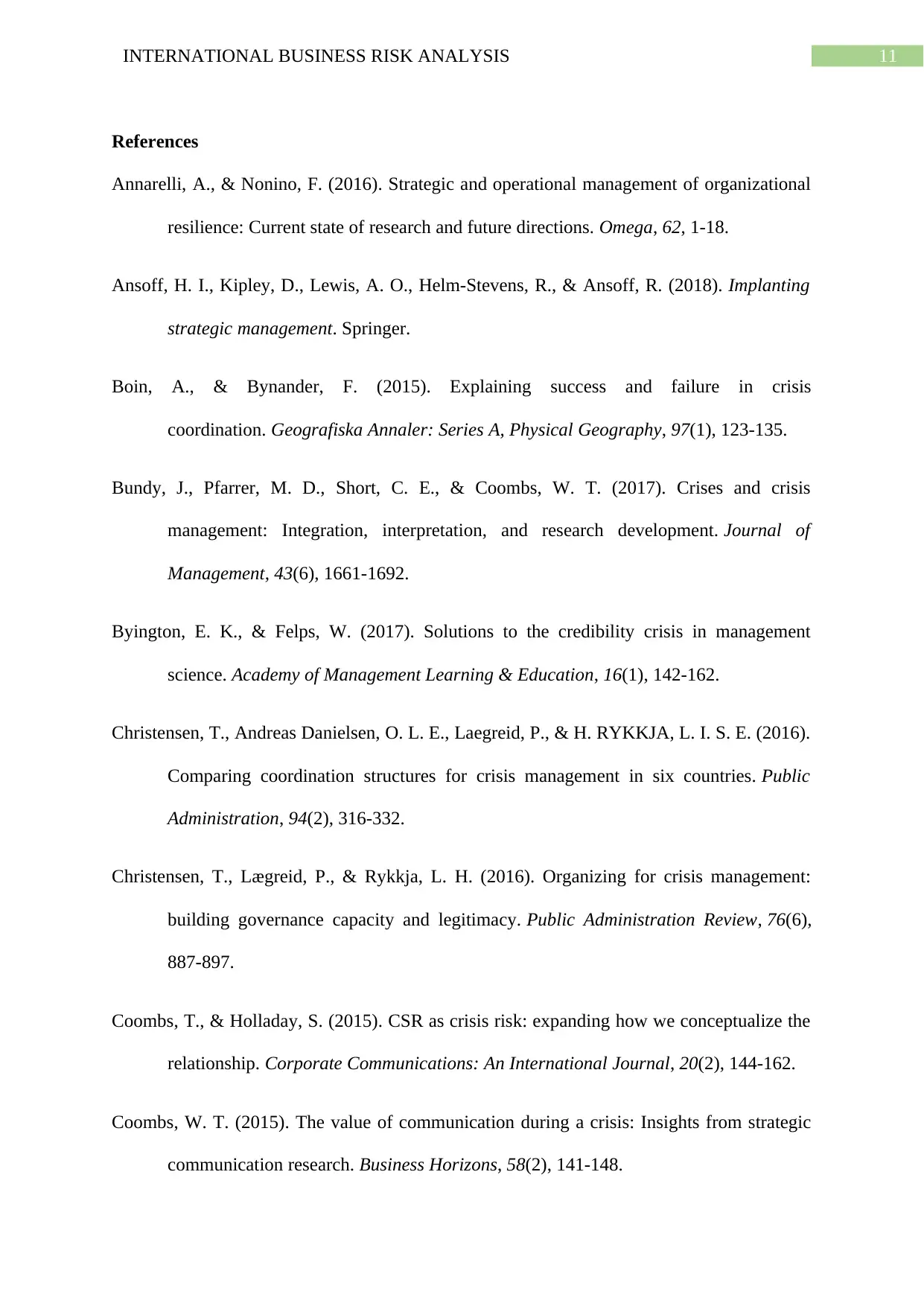
11INTERNATIONAL BUSINESS RISK ANALYSIS
References
Annarelli, A., & Nonino, F. (2016). Strategic and operational management of organizational
resilience: Current state of research and future directions. Omega, 62, 1-18.
Ansoff, H. I., Kipley, D., Lewis, A. O., Helm-Stevens, R., & Ansoff, R. (2018). Implanting
strategic management. Springer.
Boin, A., & Bynander, F. (2015). Explaining success and failure in crisis
coordination. Geografiska Annaler: Series A, Physical Geography, 97(1), 123-135.
Bundy, J., Pfarrer, M. D., Short, C. E., & Coombs, W. T. (2017). Crises and crisis
management: Integration, interpretation, and research development. Journal of
Management, 43(6), 1661-1692.
Byington, E. K., & Felps, W. (2017). Solutions to the credibility crisis in management
science. Academy of Management Learning & Education, 16(1), 142-162.
Christensen, T., Andreas Danielsen, O. L. E., Laegreid, P., & H. RYKKJA, L. I. S. E. (2016).
Comparing coordination structures for crisis management in six countries. Public
Administration, 94(2), 316-332.
Christensen, T., Lægreid, P., & Rykkja, L. H. (2016). Organizing for crisis management:
building governance capacity and legitimacy. Public Administration Review, 76(6),
887-897.
Coombs, T., & Holladay, S. (2015). CSR as crisis risk: expanding how we conceptualize the
relationship. Corporate Communications: An International Journal, 20(2), 144-162.
Coombs, W. T. (2015). The value of communication during a crisis: Insights from strategic
communication research. Business Horizons, 58(2), 141-148.
References
Annarelli, A., & Nonino, F. (2016). Strategic and operational management of organizational
resilience: Current state of research and future directions. Omega, 62, 1-18.
Ansoff, H. I., Kipley, D., Lewis, A. O., Helm-Stevens, R., & Ansoff, R. (2018). Implanting
strategic management. Springer.
Boin, A., & Bynander, F. (2015). Explaining success and failure in crisis
coordination. Geografiska Annaler: Series A, Physical Geography, 97(1), 123-135.
Bundy, J., Pfarrer, M. D., Short, C. E., & Coombs, W. T. (2017). Crises and crisis
management: Integration, interpretation, and research development. Journal of
Management, 43(6), 1661-1692.
Byington, E. K., & Felps, W. (2017). Solutions to the credibility crisis in management
science. Academy of Management Learning & Education, 16(1), 142-162.
Christensen, T., Andreas Danielsen, O. L. E., Laegreid, P., & H. RYKKJA, L. I. S. E. (2016).
Comparing coordination structures for crisis management in six countries. Public
Administration, 94(2), 316-332.
Christensen, T., Lægreid, P., & Rykkja, L. H. (2016). Organizing for crisis management:
building governance capacity and legitimacy. Public Administration Review, 76(6),
887-897.
Coombs, T., & Holladay, S. (2015). CSR as crisis risk: expanding how we conceptualize the
relationship. Corporate Communications: An International Journal, 20(2), 144-162.
Coombs, W. T. (2015). The value of communication during a crisis: Insights from strategic
communication research. Business Horizons, 58(2), 141-148.
⊘ This is a preview!⊘
Do you want full access?
Subscribe today to unlock all pages.

Trusted by 1+ million students worldwide
1 out of 14
Related Documents
Your All-in-One AI-Powered Toolkit for Academic Success.
+13062052269
info@desklib.com
Available 24*7 on WhatsApp / Email
![[object Object]](/_next/static/media/star-bottom.7253800d.svg)
Unlock your academic potential
Copyright © 2020–2025 A2Z Services. All Rights Reserved. Developed and managed by ZUCOL.




